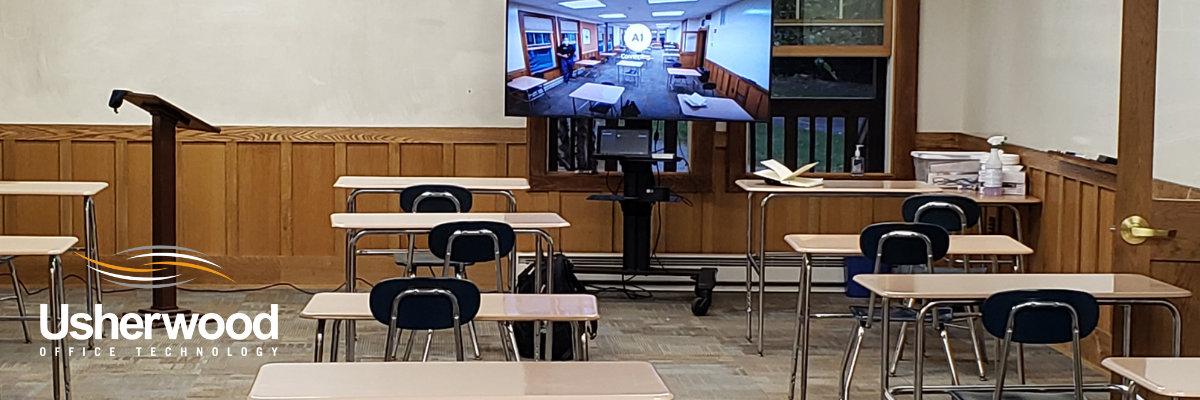By: Jada Sterling, Digital Content Manager on February 27th, 2024
How Would K-12 Schools Benefit from Cloud Communications?
As any school administrator knows, communication is key to quality education. Relaying critical information about student needs to parents and teachers can drastically affect the quality of their learning experience.
Even though effective communication is the building block of K-12 education, many K-12 schools are still living in the technological dark ages. Gone are the days when traditional corded phones, intercom systems and emails will cut it. Today’s parents, teachers, and students need more hands-on communication, and this can be done through cloud computing for education.
Here are some unique ways K-12 schools can transform their educational capabilities with the use of cloud communications.
Video Conferencing Technology
The COVID-19 pandemic transformed how school is conducted. When everyone went remote, teachers pivoted to remote learning, and in turn, virtual classes. Although this was a tough transition, it uniquely positioned teachers to learn and adapt to video conferencing solutions. Although schools have moved back into in-person learning, teachers can still use it to:
- Meet with parents with greater flexibility
- Hold virtual office hours for students who need extra help after school
- Assist students in catching up during breaks or when they’re away from school for extended time
- Communicate with other teachers when they’re unable to leave a classroom full of kids
Cloud-Based Learning Management
It can get hectic keeping students on track with current activities and future due dates, quizzes, tests, and events. That’s where cloud-based education software can help. When students have access to files stored within a cloud communications platform such as Microsoft Teams, they can stay organized with tasks and assignments, and study for exams.
Jumbled papers are often lost in a sea of folders, lockers, binders, and backpacks. Keeping materials in a centralized cloud file management system can empower students to stay on top of their responsibilities. As any teacher will tell you, organization is a key aspect of student success.
Design Engaging Lessons with Cloud-Based Learning Platforms
Nothing engages students like interactive games and activities. Teachers can screen-share games like Jeopardy, or write on virtual whiteboard tools during lessons. Aside from games, cloud tools like Microsoft Teams' "Learning Accelerators" offer help with reading, vocabulary, and other critical skills as well.
These are just a few of the ways cloud systems help students learn in ways that work for them. Lesson plans can be more dynamic and fun, with a wide range of features to interact with. In this way, cloud-based educational technology resources for teachers make teaching easier and classes more interactive.
Streamlined Parent-Teacher Communications
When things happen, parents and teachers need to reach one another. Maybe a student got a less-than-stellar grade, or they have been out sick and need to make up work. Whatever the reason, streamlined communication is key so students can learn and have their needs met both at school and at home.
Cloud platforms offer easy ways to call or text parents without teachers needing to give out personal phone numbers. Many platforms have mobile apps that teachers can use on their phones, so they can answer or send out communications on the go.
Parent-teacher meetings have never been simpler with the availability of video conferencing for education. This allows for flexible scheduling to meet the demands of busy parents and teachers. Through cloud computing at schools, everyone will be on the same page about student progression.
Messages Between Staff
Teachers, especially in K-12 schools, need to communicate with other staff without leaving the room. With a classroom full of kids, even leaving to go to the bathroom can put unsupervised students at risk. This is why cloud communication is a crucial tool for quick communication between teachers, especially if there's an emergency.
SMS
Similarly to parent-teacher communication, staff will be able to send instant messages via the cloud without worrying about giving out their phone number to everyone. This way, to reach someone in your organization, you just search their name for quick access.
Phone systems
Although most schools still operate with analog phone systems, these devices are outdated and require a lot of setup and troubleshooting. The extra hardware can quickly get expensive to add lines to, repair, or replace.
Cloud phone systems are much more budget-friendly for schools. In addition, they require much less hardware and come with updated security features. If your staff is accustomed to handsets, the good news is you can have a hybrid cloud-based system with handheld phone sets.
To read more about video conferencing equipment for classrooms or individual desks, read our article: An Ultimate Guide to Video Conferencing Equipment for Small to Large Spaces
Safety Procedures & Snow Day Communications
It can get hectic when the winter arrives and snow storms are unpredictable. That's why cloud communications are essential for sending out mass updates about school closings and delays. With applications like Teams, you can send out SMS messages to parents, staff, and students to inform them of any updates.
Safety updates are also needed for incidents such as water main breaks, fire, and other dangers. When it's unsafe for students to come to school or they must be picked up for whatever reason, reliable communication is key.
Using the cloud, mass messages can be sent easily and you can make community posts for anyone to see updates as they are released. To read about how digital signage can also help with these situations, read our blog: 5 Benefits of Using Digital Signage for Schools.
File Sharing & Eco-Friendly Solutions
It's no secret that printing excess documents is not very Earth-friendly. Because of this, it's important to have a good file management system to share and distribute documents without wasting paper or toner.
Cloud platforms such as Microsoft Teams offer file storage integrated right into the application, making it simple to find, send, and receive documents from other users. Through cloud file management, your staff will have an easier time organizing and receiving assignments.
This in turn can enhance learning as students will be less likely to lose assignments, quizzes, or worksheets in a sea of loose papers. To learn more about how to make printing more sustainable, read our article about the power of cloud printing solutions.
How to Find the Best Cloud Architecture for Your School
As you determine your information technology strategy, you might benefit from a managed communications provider with K-12 experience. The education industry has many specific details to consider, especially with technology involving video conferencing tools and cloud infrastructure.
Whether it's help with distance learning, or a need to revamp your entire cloud-based learning management system(LMS), a managed communications provider can help. If you're ready to take your K-12 school into the digital age, click the button below to talk to an expert about your needs.
Read On

10 Ways Video Conferencing Changed the Education Industry for Good
The pandemic created waves across the workforce as people were forced to work from home or...

5 Ways Colleges and Universities Can Use Cloud-Based Communication
Since the pandemic, colleges and universities have transitioned to remote learning. There is also a...

5 Benefits of Using Digital Signage for Schools
If you’re a school administrator or teacher, you know it’s getting tougher and tougher to keep...




